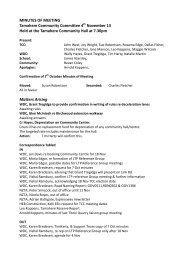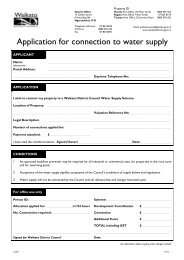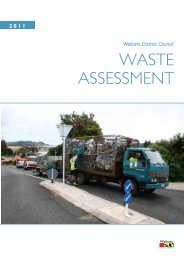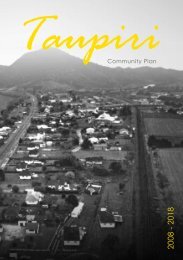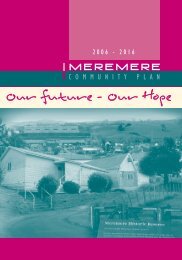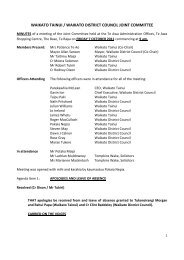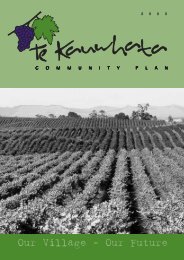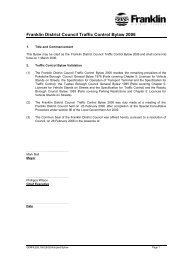1% - Waikato District Council
1% - Waikato District Council
1% - Waikato District Council
- No tags were found...
Create successful ePaper yourself
Turn your PDF publications into a flip-book with our unique Google optimized e-Paper software.
24NAVIGATING THE FUTURE | WAIKATO DISTRICT COUNCILthis development for growth upfront and recoup the fundsfrom later development contributions; while we’ve updatedthe population projections in this area, we’ve still taken aconservative approach in estimating future growth. The mainchanges relate to industrial development rather than residential.The system, which will be connected to the Watercare plant atTuakau, will be gradually extended to match growth demand.We have also begun consulting with the Pokeno communityabout connecting existing properties to the wastewaternetwork. The budget is $9.1 million, presently scheduled for2012 to 2015, funded from development contributions andcapital contributions. The proposed development contributionlevies and capital contributions can be found on pages31 and33. The costs to connect to the Watercare Treatment Plantare in addition to these programmed capital works, and areincluded in the proposed charges.Early next year, the council will be installing a wastewaterreticulation system for properties on the Whaanga Coast. Whilemost residents supported the project, cost was a contentiousissue. We know it is difficult to meet this type of cost and thereare several small towns that will also need to address thisissue in the future. In the past there was a government subsidyscheme, which we used to help fund such projects. Howeverthis is not available any more.This is why as a result of consultation feedback on this projectin 2011, we decided to adopt a 60:40 funding split between thecommunity and the council for the capital cost, with the councilmeeting its 40 per cent share from a loan with interest to becovered by the general rate. This model could be proposedto address other areas where wastewater disposal is a seriousproblem. Community consultation will be carried out at the time.We also decided to delay the capital contribution charges thatwill fund the project to 2013/14, because the connections willnot be available until the beginning of 2012/13.You can read more details on the major wastewater projectsin the Groups of Activities on page 56.StormwaterOne of our major stormwater projects is to extend reticulationin Raglan, where the clay soil makes it difficult for individualproperty owners to get rid of stormwater run-off. If this is notdealt with soon, the amount of runoff will affect the wastewatersystem and create surface flooding issues.We are also planning to upgrade stormwater systems in Huntly,Tuakau, Pokeno and Tamahere.More details about stormwater projects can be found onpage 62.RatesRates form the greater part of the council’s revenue, and weare conscious that in today’s economy, it’s not easy to makeends meet. The council has exactly the same challenge.And while we want to achieve great things for the <strong>Waikato</strong>district, we have to be realistic, and think about whether wekeep what we have well maintained, create new infrastructureand amenities or strike a medium between the two and if so,how. With affordability in mind, we also wanted to minimisethe rates increase.In 2011, we reviewed our rates structure, and the propertyrevaluations were also carried out so in future, the revaluationswill be done at the same time in the former Franklin and<strong>Waikato</strong> districts.The last valuation straddled the economic crisis, so there werebig movements for the former <strong>Waikato</strong> district.The capital value in the former Franklin district properties nowaccounts for a greater percentage of the overall district’s capitalvalue. While the movement overall was about 2 per cent, therewill be big variances between different sectors such as rural,urban, lifestyle.The property valuations are used as a basis to calculate howmuch you are charged.Secondly, the rates structure is about how much of the fundsraised come from general rates, targeted rates for servicesreceived (such as for refuse, halls, wastewater etc), or a uniformannual general charge (UAGC) – in other words, how the ratesare apportioned.As a result of the review, we changed the rate of the UniformAnnual General Charge from 22 per cent to 25 per cent($403).Targeted rates for stormwater were also changed. We heardcompelling argument from residents on the question of payingstormwater rates based on capital value. Stormwater will nowbe charged as a uniform targeted rate for all urban stormwatercatchments ($194.26).We have also included the former Franklin targeted rates forTuakau town upgrade, transport, economic development andthe Hunua Rural Fire into the general rate.The combined effects of the amalgamation of part of theformer Franklin area and <strong>Waikato</strong> district, the merging of twodifferent rating systems and the property revaluation alignmenthas had a significant effect on rates for some properties.Therefore we have adopted a one-off, two-year policy to helpaddress the rates increases brought about by these changes.This is part of our whole affordability of rates proposal. Wewill fund it from interest earned on the Franklin <strong>District</strong>Development Fund, which is a reserve fund from the sale ofthe former Franklin district’s Auckland Airport shares. When thetransitional rate policy ceases in two years, this interest will goto reducing the general rate, as happens with interest from theHamilton East Property Reserve. The cost will be $204,515 in2013 and $23,257 in 2014. The remission policy can be foundon page 131 in Volume Two.The policy doesn’t apply to properties where the rates haveincreased simply because of additional capital improvements.The table on the next page shows the limits to qualify for the



